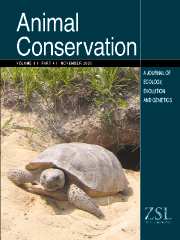Crossref Citations
This article has been cited by the following publications. This list is generated based on data provided by
Crossref.
Redpath, S. M.
Arroyo, B. E.
Etheridge, B.
Leckie, F.
Bouwman, K.
and
Thirgood, S. J.
2002.
Temperature and hen harrier productivity: from local mechanisms to geographical patterns.
Ecography,
Vol. 25,
Issue. 5,
p.
533.
Redpath, Steve
Amar, Arjun
Madders, Mike
Leckie, Fiona
and
Thirgood, Simon
2002.
Hen harrier foraging success in relation to land use in Scotland.
Animal Conservation,
Vol. 5,
Issue. 2,
p.
113.
Amar, Arjun
Redpath, Steve
and
Thirgood, Simon
2003.
Evidence for food limitation in the declining hen harrier population on the Orkney Islands, Scotland.
Biological Conservation,
Vol. 111,
Issue. 3,
p.
377.
AMAR, ARJUN
and
REDPATH, STEPHEN M.
2005.
Habitat use by Hen HarriersCircus cyaneuson Orkney: implications of land‐use change for this declining population.
Ibis,
Vol. 147,
Issue. 1,
p.
37.
Bro, Elisabeth
Arroyo, Beatriz
and
Migot, Pierre
2006.
Conflict between grey partridge Perdix perdix hunting and hen harrier Circus cyaneus protection in France: a review.
Wildlife Biology,
Vol. 12,
Issue. 3,
p.
233.
Schoech, Stephan J.
and
Hahn, Thomas P.
2008.
RETRACTED ARTICLE: Latitude affects degree of advancement in laying by birds in response to food supplementation: a meta-analysis.
Oecologia,
Vol. 157,
Issue. 3,
p.
369.
AMAR, ARJUN
ARROYO, BEATRIZ
MEEK, ERIC
REDPATH, STEVE
and
RILEY, HELEN
2008.
Influence of habitat on breeding performance of Hen Harriers Circus cyaneus in Orkney.
Ibis,
Vol. 150,
Issue. 2,
p.
400.
Pandolfi, Massimo
and
Tanferna, Alessandro
2009.
Long-Term Change in Population Size and Reproductive Parameters of Montagu's Harriers (Circus pygargus) in Italy.
Journal of Raptor Research,
Vol. 43,
Issue. 2,
p.
155.
THORUP, KASPER
SUNDE, PETER
JACOBSEN, LARS B.
and
RAHBEK, CARSTEN
2010.
Breeding season food limitation drives population decline of the Little Owl Athene noctua in Denmark.
Ibis,
Vol. 152,
Issue. 4,
p.
803.
Amar, Arjun
Davies, Jacob
Meek, Eric
Williams, Jim
Knight, Andy
and
Redpath, Steve
2011.
Long‐term impact of changes in sheep Ovis aries densities on the breeding output of the hen harrier Circus cyaneus.
Journal of Applied Ecology,
Vol. 48,
Issue. 1,
p.
220.
WILSON, MARK W.
O’DONOGHUE, BARRY
O’MAHONY, BARRY
CULLEN, CHRIS
O’DONOGHUE, TIM
OLIVER, GEOFF
RYAN, BARRY
TROAKE, PAUL
IRWIN, SANDRA
KELLY, THOMAS C.
ROTELLA, JAY J.
and
O’HALLORAN, JOHN
2012.
Mismatches between breeding success and habitat preferences in Hen Harriers Circus cyaneus breeding in forested landscapes.
Ibis,
Vol. 154,
Issue. 3,
p.
578.
Hayhow, Daniel B.
Eaton, Mark A.
Bladwell, Stephen
Etheridge, Brian
Ewing, Steven R.
Ruddock, Marc
Saunders, Richard
Sharpe, Chris
Sim, Innes M.W.
and
Stevenson, Andrew
2013.
The status of the Hen Harrier,Circus cyaneus, in the UK and Isle of Man in 2010.
Bird Study,
Vol. 60,
Issue. 4,
p.
446.
AMAR, ARJUN
and
ESSELSTYN, JACOB A.
2014.
Positive association between rat abundance and breeding success of the Critically Endangered Mariana Crow Corvus kubaryi.
Bird Conservation International,
Vol. 24,
Issue. 2,
p.
192.
Madden, Christine F.
Arroyo, Beatriz
Amar, Arjun
and
Sanchez‐Zapata, Jose A.
2015.
A review of the impacts of corvids on bird productivity and abundance.
Ibis,
Vol. 157,
Issue. 1,
p.
1.
Cunningham, S. J.
Madden, C. F.
Barnard, P.
Amar, A.
and
Duncan, Richard
2016.
Electric crows: powerlines, climate change and the emergence of a native invader.
Diversity and Distributions,
Vol. 22,
Issue. 1,
p.
17.
Wilson, Mark W.
Fernández-Bellon, Darío
Irwin, Sandra
and
O’Halloran, John
2017.
Hen HarrierCircus cyaneuspopulation trends in relation to wind farms.
Bird Study,
Vol. 64,
Issue. 1,
p.
20.
Krüger, Sonja C
and
Amar, Arjun
2017.
Productivity of the declining Bearded Vulture Gypaetus barbatus population in southern Africa.
Ostrich,
Vol. 88,
Issue. 2,
p.
139.
Roos, Staffan
Smart, Jennifer
Gibbons, David W.
and
Wilson, Jeremy D.
2018.
A review of predation as a limiting factor for bird populations in mesopredator‐rich landscapes: a case study of the UK.
Biological Reviews,
Vol. 93,
Issue. 4,
p.
1915.
Murgatroyd, Megan
Redpath, Stephen M.
Murphy, Stephen G.
Douglas, David J. T.
Saunders, Richard
and
Amar, Arjun
2019.
Patterns of satellite tagged hen harrier disappearances suggest widespread illegal killing on British grouse moors.
Nature Communications,
Vol. 10,
Issue. 1,
Caravaggi, Anthony
Irwin, Sandra
Lusby, John
Ruddock, Marc
O'Toole, Lorcán
Mee, Allan
Nagle, Tony
O'Neill, Shane
Tierney, David
McCarthy, Alan
and
O'Halloran, John
2019.
Factors influencing Hen HarrierCircus cyaneusterritory site selection and breeding success.
Bird Study,
Vol. 66,
Issue. 3,
p.
366.


